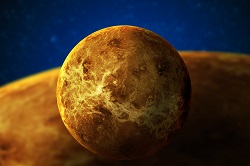Trending Science: Venus wave may be the Solar System’s largest
Known as a stationary gravity wave, the wave of hot air rises up from Venus’s surface and stretches across its entire diameter. It hovers about 65 kilometres (40 miles) above the surface in the shape of a flattened ‘V’, rippling through Venus’s sulphuric acid clouds that blow at a chaotic and constant 354 kph (220 mph). The anomaly lasts for up to three Earth days then mysteriously vanishes. The gravity wave is impossible to see with human eyes but it could be described as looking like a series of ripples in clouds on Earth that stretches over 10 000 km all the way from the Arctic to the Antarctic. Luckily, the Japanese Venus-orbiting Akatsuki (Venus Climate Orbiter) spacecraft saw and photographed the wave for the first time in infrared light. Now publishing their research after a year of analysing the data in the journal ‘Nature Geoscience’, the Japanese research team, based at Rikkyo University in Tokyo and the Japan Aerospace Exploration Agency (Jaxa) have described in much greater detail the uniqueness and oddities of Venus’s stationary gravity wave. Curiously, the bright anomaly remained stationary at the altitude of Venus’s cloud tops, making it difficult to reconcile with what we know about Venus’s thick upper atmosphere, where clouds race past at 100 m per second. The clouds travel much faster than the slowly rotating planet below, where a day on Venus actually lasts longer than a Venusian year. The Japanese team hypothesise that the phenomenon is the result of a gravity wave that is generated as the lower atmosphere passes over mountains and then propagates upwards through Venus’s thick atmosphere. Gravity waves ensue when a fluid is displaced from a position of equilibrium and are well known to meteorologists and atmospheric scientists here on Earth, who see them as ripples through clouds of water vapour and ice. On Earth, gravity waves are pretty small due to the comfortably dense atmosphere. Venus, which even though like is Earth is a rocky planet with a persistent atmosphere, clouds and roughly 82 % the mass and 90 % the surface gravity of Earth, could easily be described as the worst place you could ever want to visit in our Solar System. On the surface, the air is nearly 97 % carbon dioxide (about 100 times thicker than on Earth) and a balmy 462 degrees Celsius, which is hot enough to melt even lead... and explains why a spacecraft can’t survive for more than a few hours on Venus. The Akatsuki spacecraft is due to orbit Venus for another couple of years and it is hoped that it may yet again detect more of these waves, hopefully furthering deeper understanding of one of Earth’s closest neighbours.
Countries
Japan



